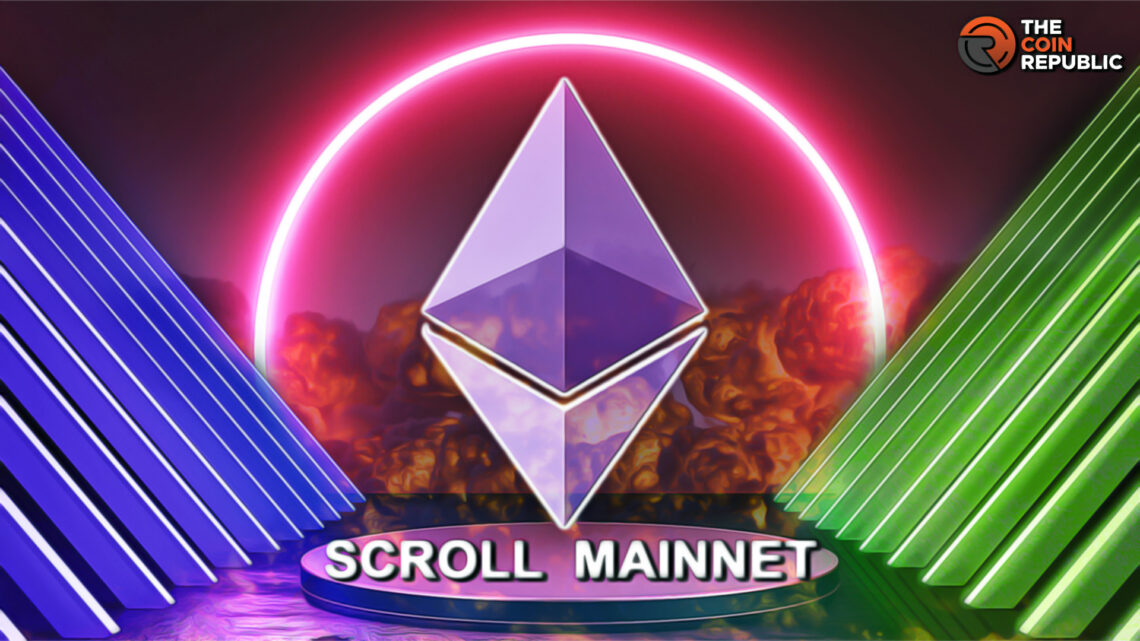- 1 Scroll is a zkEVM technology-based Layer-2 scaling solution for the Ethereum blockchain.
- 2 Developing for over 2 years, it finally announced its mainnet launch.
- 3 Experts see it as a big milestone for speeding up transactions on Ethereum and making the ecosystem highly robust.
Scroll, a Layer-2 scaling solution for Ethereum developers, has confirmed its mainnet launch, and is shortly going live. However, other reports suggest that it has already gone live over a week ago. The announcement came on October 7, 2023, via the official Twitter handle of the company.
After more than two years of building, we are thrilled to announce the launch of Scroll Mainnet.
— Scroll 📜 (@Scroll_ZKP) October 17, 2023
As we open the doors to Mainnet, we want to take a moment to reflect on our journey thus far 💛 pic.twitter.com/WKfkjyIkB0
The team behind the company had been constantly working on building the launch-ready platform for over 2 years. It said that the company conducted testing runs and security audits. The process of building went on for an extensive period of 15 months to come up with an excellent Zero Knowledge Proof-enabled Layer-2 network, compatible with the Ethereum Virtual Machine (EVM).
It endorses itself as “an L2 network built by Ethereum developers for Ethereum developers”, meant as a scalability solution on top of the Ethereum blockchain.
The team added that the developers can now conveniently migrate Software Development Kits (SDKs) and other applications, from Ethereum’s Layer-1, over to the new EVM-compatible L2.
The co-founders also went live for a Discord community call, where they talked all about what the launch means for the developer community of the Ethereum network. The call was hosted by Sandy Peng, Shen Haicheng, and Ye Zhang. They also made major claims regarding the boost of speed for the entire Ethereum network.
A Brief Guide on Scroll Network
Scroll network is a Layer-2 scaling solution for Ethereum that employs Zero Knowledge Rollups specifically designed to be integrated with the Ethereum mainnnet’s EVM computation engine. They call it– zkEVM, which distinguishes itself from the rest in the market as a zk-rollup for building generalized composable dApps.
These can efficiently migrate the existing Ethereum-based applications, as opposed to other zk-rollups that are application-specific, and so, very inefficient to generate zk-proofs for the generic EVM verification.
Notably, zk-rollups are said to be the best-in-class layer-2 scaling solutions, especially for Ethereum, that are the most cost-effective, providing a high degree of security at the same time. It has the shortest finalizing time, and each rollup can aggregate a huge number of transactions into one block and, hence, help increase throughput.
zkEVM of Scroll employs Polynomial Commitment schemes to produce succinct zero-knowledge proof protocols. It also integrates Lookup Table arguments like AND and XOR, which were earlier known to be zk-unfriendly. The Lookup Table arguments are successfully integrated by using new and improved algorithms of PLONK (Permutations over Lagrange-bases for Oecumenical Non-interactive arguments of Knowledge), such as– UltraPLONK and TurboPLOK. Alongside, Recursive ZKPs are employed as well.
The Journey Culminating into the Successful Launch
Scroll was founded in 2021, by the Ethereum developers Sandy Peng, Shen Haicheng, and Ye Zhang, with the mission to scale Ethereum in the most secure and cheapest way. Prior to the mainnet launch, it went through 3 testnets spread across more than a year’s time period.
Looking for solutions to establish scalability issues in Ethereum L-1, after thorough research, the researchers from the developer community of the world’s largest blockchain, zeroed upon the zkEVM technology. It had to incorporate many improvements over the existing zk-rollups to emerge a whole new protocol for zkEVM.
Keeping up with the original vision of Vitalik Buterin, the zkEVM protocol has been completely open-source since its inception. Apart from that, the team focused greatly on their platform to be developer-friendly and highly secure. Security of the code was given the utmost importance for it to remain invulnerable to attacks.
Throughout the testnet run, 450 smart contracts were deployed in total that concluded over 90 Million transactions, at an average of n 305,000 transactions per day. The testnet concluded at a figure above 9 Million blocks of the layer-2 chain. These rollups were highly efficient as they produced a total of around 280,000 ZKPs during the test run. Furthermore, the network also hosts a recently released testnet– Scroll Sepolia to allow for the test runs of the upcoming upgrades to the mainnet.
Finally, rigorous auditing was conducted for all the rollups and smart contracts, along with security tests, by Open Zeppelin and Zellic. The zkEVM circuits were audited by Zellic, Trail of Bits, and Kalos Security.
Scroll Architecture
The architecture of the Layer-2 blockchain consists of 3 main components—
- Scroll Node: These nodes are responsible for constructing the blocks in the second layer, integrating them with the ETH base layer. It also handles communication between L1 and L2.
- Roller Network: It is responsible for efficiently and accurately generating zkkEVM proofs that will be used to verify the transactions. The proofs are generated for each zkEVM circuit of the network.
- Rollup and Bridge Contracts: This layer acts as the relayer of the data for Scroll transactions that must be made available for accurately verifying zkEVM validity proofs. Then the bridge contracts allow users to move assets between the Ethereum base layer and the Scroll second layer. They basically bridge ERC-20 assets to securely move across binary directions.
The Update
Though the announcement for the mainnet going live came on October 17 via Twitter, the blockchain data of Scroll reveals that it has been operating live since October 8. That’s when the first smart contract was deployed on the L2 chain, the EtherScan data revealed. The team waited for more than a week to make the official announcement.
Scroll is an open-source, scalable, cryptographically secured, Ethereum-aligned, modular Layer-2 chain that sets out to make the Ethereum ecosystem highly scalable. The space is evidently witnessing much competition with many organizations and applications coming up with zk-rollup solutions.
According to Jordi Baylina, the technical head of Polygon Hermez, a new generation zkEVM by Polygon, “competition in the zkEVM space is going to make the ecosystem more robust,” and, “Having different projects adds a lot of experience, and it’s also a way to test different approaches, ways of handling things, or solving things,”.

With a background in journalism, Ritika Sharma has worked with many reputed media firms focusing on general news such as politics and crime. She joined The Coin Republic as a reporter for crypto, and found a great passion for cryptocurrency, Web3, NFTs and other digital assets. She spends a lot of time researching and delving deeper into these concepts around the clock, and is a strong advocate for women in STEM.


 Home
Home News
News







